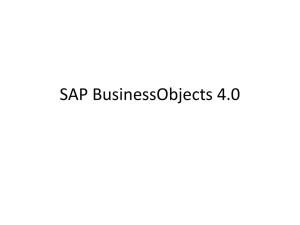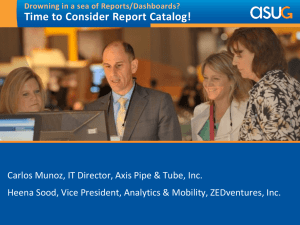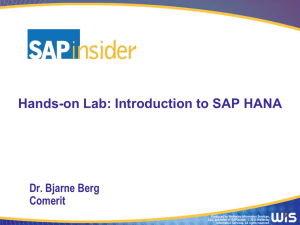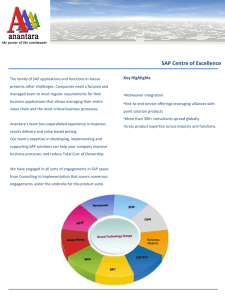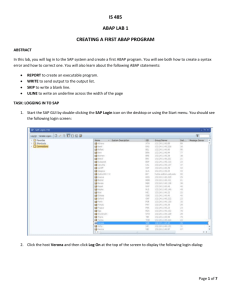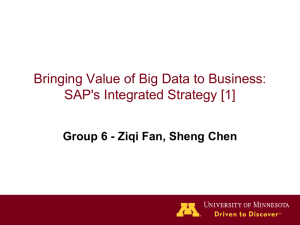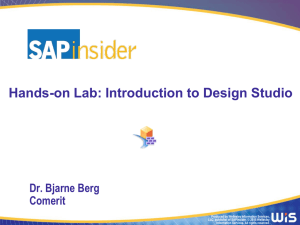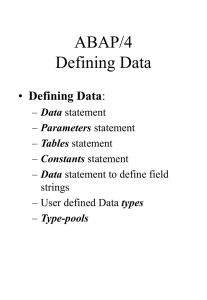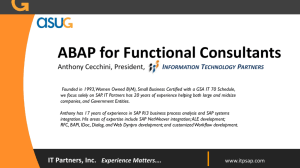Alert Reporting Summary - SCN Wiki
advertisement
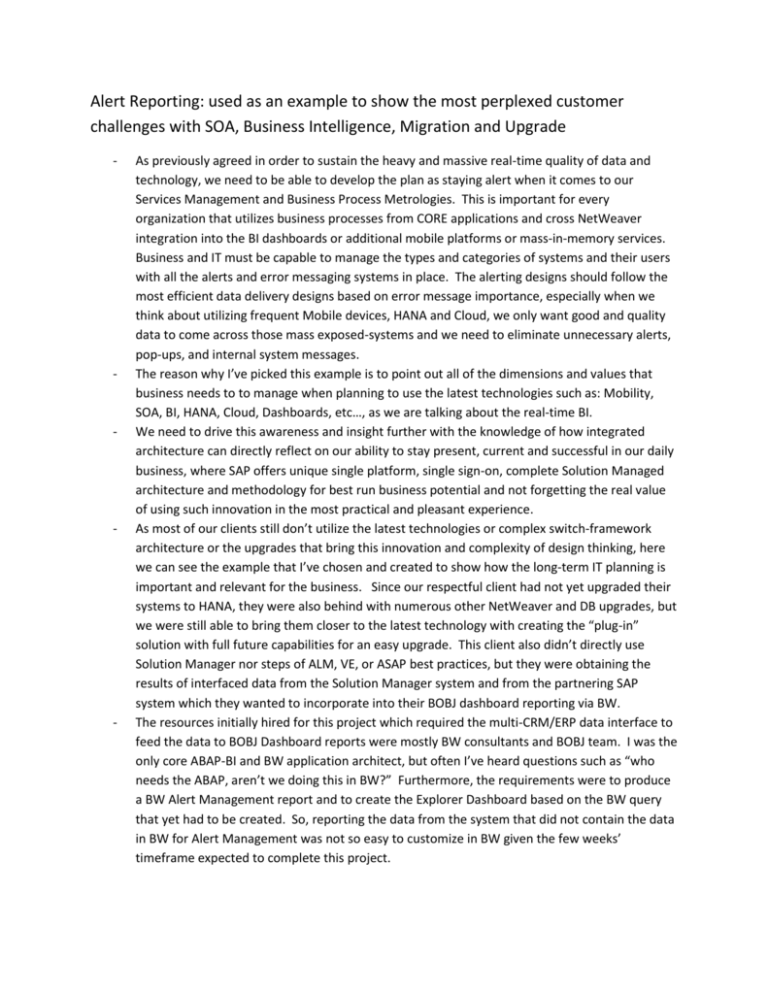
Alert Reporting: used as an example to show the most perplexed customer challenges with SOA, Business Intelligence, Migration and Upgrade - - - - - As previously agreed in order to sustain the heavy and massive real-time quality of data and technology, we need to be able to develop the plan as staying alert when it comes to our Services Management and Business Process Metrologies. This is important for every organization that utilizes business processes from CORE applications and cross NetWeaver integration into the BI dashboards or additional mobile platforms or mass-in-memory services. Business and IT must be capable to manage the types and categories of systems and their users with all the alerts and error messaging systems in place. The alerting designs should follow the most efficient data delivery designs based on error message importance, especially when we think about utilizing frequent Mobile devices, HANA and Cloud, we only want good and quality data to come across those mass exposed-systems and we need to eliminate unnecessary alerts, pop-ups, and internal system messages. The reason why I’ve picked this example is to point out all of the dimensions and values that business needs to to manage when planning to use the latest technologies such as: Mobility, SOA, BI, HANA, Cloud, Dashboards, etc…, as we are talking about the real-time BI. We need to drive this awareness and insight further with the knowledge of how integrated architecture can directly reflect on our ability to stay present, current and successful in our daily business, where SAP offers unique single platform, single sign-on, complete Solution Managed architecture and methodology for best run business potential and not forgetting the real value of using such innovation in the most practical and pleasant experience. As most of our clients still don’t utilize the latest technologies or complex switch-framework architecture or the upgrades that bring this innovation and complexity of design thinking, here we can see the example that I’ve chosen and created to show how the long-term IT planning is important and relevant for the business. Since our respectful client had not yet upgraded their systems to HANA, they were also behind with numerous other NetWeaver and DB upgrades, but we were still able to bring them closer to the latest technology with creating the “plug-in” solution with full future capabilities for an easy upgrade. This client also didn’t directly use Solution Manager nor steps of ALM, VE, or ASAP best practices, but they were obtaining the results of interfaced data from the Solution Manager system and from the partnering SAP system which they wanted to incorporate into their BOBJ dashboard reporting via BW. The resources initially hired for this project which required the multi-CRM/ERP data interface to feed the data to BOBJ Dashboard reports were mostly BW consultants and BOBJ team. I was the only core ABAP-BI and BW application architect, but often I’ve heard questions such as “who needs the ABAP, aren’t we doing this in BW?” Furthermore, the requirements were to produce a BW Alert Management report and to create the Explorer Dashboard based on the BW query that yet had to be created. So, reporting the data from the system that did not contain the data in BW for Alert Management was not so easy to customize in BW given the few weeks’ timeframe expected to complete this project. - As client continued to view this and other reporting requirements from the perspective of “Artificial BI Intelligence” where BW reports are planned to be used as an input to the BOBJ Dashboards, the critical challenge was to innovate this process and to educate the entire team that major transformation in their BI design should take a place. - My immediate focus was to integrate the end-to-end architecture where I can demonstrate the quick interfaces designed with ABAP / Data Services and Explorer Dashboard, or ABAP / Crystal directly which we were able to accomplish in a few days; and at the same time we were building the BW data store information, and designing the ABAP program to load the data from Solution Manager interface and CRM into BW data store. - While our client still wanted the BW report which was supposed to be designed in several weeks with 2-3 BW resources, and a few BOBJ resources to continue with Xcelsius, Crystal, or Explorer graphical presentations of Alert Reporting dashboard, very quickly they were able to realize that I’ve designed the alternate real-time solution using the ABAP design to Crystal or ABAP – Data Services – Explorer interface report which can also be used with integration to HANA or other similar applications. - Below we see a simple sketch of solutions that I’ve proposed, designed and programmed, so to demonstrate these multiple perspectives and choices that our client can have as models for any future BI development. - The purpose of this report designed with ABAP was to show to our customer how this would be a quicker and direct option to interface data with BOBJ instead of passing data horizontally to BW and going thru extra building and customizing to only create the queries that would need to be replicated again if HANA or other applications are to be integrated in the future. - With successful testing of ABAP – Data Services – Crystal – Explorer Dashboard report client agreed that BW steps would be unnecessary and they’ve decided to use this model instead. - The three BI and SOA scenarios of the Alert Reporting interface and reporting design were presented in a simple form: 1. Short Term and Long Term Objectives were defined in relation to data challenges and nonexisting interfaces cross two different SAP systems and lack of BW content, all requiring a crossplatform integration: NetWeaver, Unix, Windows. Step A was a short-term solution with data download via ABAP program and data written into custom table form where Crystal or BOBJ applications can access the data directly (similarly HANA can access this data as well for any future reference). 2. Step B demonstrates what would be required to load the Alert Management Data into BW. For BW, we would need to create the Data Store structure and to continue to provide data by writing a custom function or ABAP custom feed; and then to create the Open Hub BW process chain. Once data is in BW we would still need to create the necessary BW custom providers and to design the BW / Bex Query that Crystal can import directly. Another option would be to use the Open Hub functionality which we had tested successfully after ABAP program loaded the data into the custom Data Store designed. Still, that took extra programming and extra data load and we’ve identified that as more costly. Since we were able to utilize Data Services code for cross platform data integration purposes, it was easier for us to settle with option C instead (this was tailored so if one day HANA will be implemented that all of the customizing done in BW would require to be re-built in HANA ). 3. Step C was decided to be the ultimate model for our Long Term solution. I’ve designed and programmed this interface in addition to demonstrate that prior prototyped solutions A and B (based on client’s existing system capabilities and preferences) were most innovative when using the C model approach. I’ve written the program with automated scheduling of the batch job created to extract the Alert Management data dynamically based on the dynamic system id where data was extracted from. This background job and data transfer was executed across the UNIX and Windows platforms where Data Services job would be activated with event detecting of a new file arriving from which-ever system was executing this program. Explorer Dashboard Alert Management report was then further created based on Data Services job completed and data being available for more creative BOBJ reporting. This process and architecture was delivering in real-time or close-to the real time data execution. Five different Corporate Portal reports were designed out of this data:: i) Alerts Overview ii) Alerts by System Component iii) R/3 Alerts by Admin Group iv) CCMS Alerts by System v) All Alerts by Month Example: Graphic A 4. Solutions as such allow customers to approach the “Self-Service” BI in more dynamic and flexible and user friendly way. Leveraging free and open form NetWeaver architecture and BOBJ capabilities this report was empowered by core master data applications and back-end design, without the need to duplicate any efforts if the later technologies will be used, such as HANA, Cloud, Mobile reporting delivery, etc... 5. Delivered Short Term solution was a pre-requisite for BOBJ team to learn and comprehend the SAP framework and end-to-end design better, and also to complete in parallel the designs and testing of Crystal Graphical prototype, or Explorer views and layouts desired, which would lead to completely understanding the long-term requirements and resource planning. By delivering the short-term solution A initially, BOBJ team had to fine-tune the BOBJ configuration and had opportunity to additionally test and upgrade on their end necessary releases to produce such reporting. Option B also allowed the team to explore the Open Hub functionality and eliminate the need for additional BW Queries, duplicated coding, extra complex design and time constraints designing and loading Data Store, DSO, transformation to Cube and continued custom data load. Furthermore, they were able to add-on the BOBJ related specific requirements and extended the integrated architecture. The final design delivered the Explorer Dashboard reporting with real time delivered and automated data (for their current release and system landscape). This diversified approach had helped the team to stay productive and to learn during the short-term phase execution. This also gave management the understanding on how far from “planned” and “realized”, “understood” and “feasible” they were standing at the time. In order to replicate this entire process in BW, client management was finally able to understand that it would require doubling the project efforts, not obtaining the real-time BI but continuing to use the “Artificial Intelligence” models, and the project duration would be extended, but no extra value would be achieved based on their existing situation. 6. As we’ve delivered some preliminary BW proof of concepts, and completed our data load into the BW Data Store with Alert Management data passed from another system, we were able to show how far this deign would fall behind from the alternate approach. The extended programming and customizing necessary to overcome BW missing content would be a complete overhead. As this proved to be a less cost effective method, and less productive solution, we’ve decided to use models A and C and to eliminate option B, even though a BW solution was a preferable and fully staffed BW requirement initially. Steps A and C are much easier and faster to implement, more efficient as demonstrated with these examples, and more valuable also for re-use and integration of the future releases eliminating any wasted efforts or repetition. 7. In summary: The Long Term Solution for Alert Reporting was realized successfully not only for the reporting design purposes itself, but also from the data quality and integrity perspective. Little bit about BTS: SAP BTS studies continue to place its focus on integrated value delivery by incorporating modern technologies into old and new methodology and principles derived from the academic aspects of process deigns and architecture engineering that our clients lead with their innovations as well. BTS team promotes Business Process Management teachings, ASAP 7.1 and latest Methodologies, ARIS Modeling, Organizational Change Management aspect and sensitivity to learning, adaptation, and transformation of SAP new solutions. Methodology delivered with BTS principles has proven methods for empowered governance and monitoring of the project directives, results and costs. Without the entire BTS outlook and approach many designs would have taken the wrong direction or too costly outcome. BTS teams bring Business Process Experts who deliver the enterprise architecture that fits the best to our customer’s needs. Little bit about Value Management and its use: - - - So what is the true value that we are all trying to obtain by any new design and architecture? In situations that require a complex BI or SOA scenarios and where customer’s requirements are not maturely interpreted but they are still driving the innovation, resources and budgets, having the expert that can recognize the value is the key pointer for entire project direction and later success. The principles of extended architecture combined with experience of integrated programming techniques make or break the models of SOA and BI elegant delivery. It is also very valuable to obtain the clear definition and to document the true “as-is” model. Once we are all able to articulate and to understand the requirements of the existing model, only then we can begin the discussions on “to-be” design. Experts can tell in a matter of first few days, what should be planned in first project phases, by delivering the initial roadmap. Experts can also point customers to those areas in their processes and their system where they could realize the highest value. A true value scale needs to have more indicators than the few that we are mostly using. True value is in expert’s advice, hard work and experience and not in the expert’s resume. A true value is in design thinking which does not require a lot of $$$ spent but a carefully planned project with multiple options and prototypes to choose from. A true value is in definition of the true project design and clearly understood business purpose. A true value is not in competing for something popular but delivering it with full value. All along I had this picture in my head, and asking myself “why would I pass data horizontally from one business suite to another when I can aim directly and pass data to BOBJ in a realtime technique? Respectful and equal contributors to this development were: ABAP and BOBJ: Volker Wintzheimer volker.wintzheimer@sap.com and Cuen Gower-Winter, cuen.gower-winter@sap.com BW innitiatives: Vivek Vellagandula vivek.vellagandula@sap.com BASIS support and Database Administration : Rakesh Thakkar rakesh.thakkar@sap.com and Larry Bird larry.bird@sap.com BOBJ Project Manager: Maureen Tonetta maureen.tonetta@sap.com BPX Enterprise Architect and ABAP Developer: Alexandra Weber alexandra.weber@sap.com Alexandra Weber SAP BTS Delivery BPX Enterprise Architecture Consultant Alexandra.Weber@sap.com
